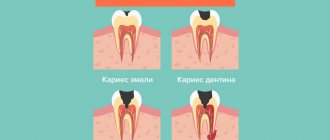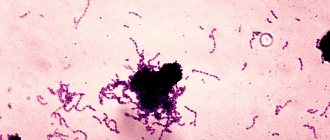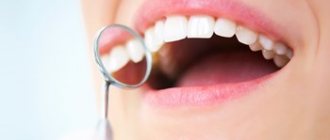Caries can affect children's teeth even at the eruption stage. By the age of 7 years, it is diagnosed in 80% of young patients. But most parents do not focus on this problem. Meanwhile, it is necessary to treat not only permanent teeth, but also milk teeth, since they are also susceptible to pulpitis and can cause purulent infection and other complications. To treat caries in children today, it is not necessary to drill teeth. Modern dentistry has minimally invasive techniques - silvering, fluoridation, infiltration.
Causes of caries
Caries occurs “thanks” to microorganisms living in the thickness of dental plaque. These bacteria - primarily streptococci, lactobacilli and actinomycetes - process food debris that remains on the teeth and produce acids that corrode the tooth enamel, leaching calcium from it. The tooth enamel begins to deteriorate.
The activity of bacteria varies from person to person: it is higher if a person brushes their teeth irregularly or not thoroughly enough, since soft interdental plaque is an excellent nutrient medium for them.
Possible causes of caries in children
- Poor dental hygiene.
- Poor nutrition. Bacteria multiply more actively in the mouth of people who prefer foods with a high content of easily digestible carbohydrates and sugars.
- Insufficient production of saliva, its increased viscosity.
- Lack of solid foods in the diet, which helps remove soft plaque.
- Lack of calcium and phosphorus in food.
- Lack of fluoride in water (below 1.5 mg/l).
- Crowding of teeth, since it is impossible to clean plaque from the interdental space in this case.
- Some diseases predispose to increased activity of the carious process: diabetes mellitus, thyroid disease.
Clinical picture of caries
The first stage of the carious process
Caries occurs in the spot stage and in the superficial layers of enamel. Then we observe a stain on the surface of the tooth, which gradually becomes more dull, rough and porous.
The second stage of the carious process
If the enamel is chipped and a defect is formed, the tooth becomes more sensitive to irritants. Transient pain appears after eating cold, sweet and sour foods.
The third stage of the carious process
A carious cavity in dentin (tooth tissue located under the enamel). In this case, toothache appears depending on the situation, for example, when chewing on a diseased tooth or when there is a sudden change in the temperature of food, air, or when food gets into the cavity of a damaged tooth.
The fourth stage of the carious process
With further destruction, a deep carious cavity appears in the tooth, which gradually increases in size, so that eventually the tooth is destroyed and the pain appears spontaneous and constant. At this stage, an urgent visit to the dentist is necessary, as this indicates damage to the nerve of the tooth. In this case, it is not always possible to save the tooth.
Meet our tooth fairies and find out prices
Stages of the carious process
The carious process on baby teeth is more intense, this is due to the structural features of the enamel and dentin of children's teeth. The hard tissues of the tooth are poorly mineralized, the surface of the tooth is more porous, and the dental pulp is immature.
The first stage is a carious spot. If the plaque that has formed on the surface of the tooth is not removed within 24 hours, then the bacteria inhabiting it begin to actively reproduce. acids are formed that wash away fluoride and calcium from tooth enamel. As a result, cariogenic bacteria penetrate deeper into the tooth and damage it. This is the first stage of caries - a carious spot. At this stage, the process is quite easily reversible; it can be cured even without a drill. There is a modern and safe method of chemical-mechanical treatment of tooth enamel with a special gel - ICON. At this stage, it is almost impossible to determine tooth decay on your own, which is why it is recommended to visit the dentist regularly.
In the second stage - initial caries , bacteria damage dentin, thereby forming visible tooth decay. The tooth begins to react briefly to cold and sweet stimuli. If there is a cavity (even the smallest one), ICON will not help - invasive treatment with removal of carious tissue and filling is required.
The third stage is middle caries . Here, bacteria cross the enamel-dentin boundary, and dentin destruction occurs faster than enamel. In an adult, the process will be slow. Since protective dentin begins to be produced, the tooth “fights” the disease, but in baby teeth such protection is significantly lower. At this stage there is already a carious cavity, which is probed. And the reaction to irritants is more pronounced, food begins to get stuck in the cavity.
The fourth stage is deep caries. Bacteria penetrate closer and closer to the center of the tooth, to the pulp. By this time, most of the dentin has already been destroyed, there is a large carious cavity, the tooth reacts strongly to irritants: cold. hot, sweet, the pain goes away only with time, but at this stage the tooth itself does not hurt yet. In all three cases: from initial to deep caries, the tooth can be cured by placing a regular filling. inlay or crown, leaving the tooth “alive”.
The fifth stage is pulpitis. This is already inflammation of the neurovascular bundle located in the pulp chamber. These tissues are destroyed. Accompanied by severe throbbing pain, both in response to irritants and spontaneously. Very often, parents pay attention to tooth decay in their child only at this moment, the toothache is very acute and a visit to the dentist is urgent.
The sixth stage is periodontitis. This is an inflammatory process outside the tooth. It can be asymptomatic in an already pulpless tooth and lead to complex consequences. such as bone loss. At this stage, the tooth hurts when eating hot food or biting.
Diagnosis of caries in children
How to recognize caries in a child? A parent cannot always do this, since caries in children becomes noticeable only when there is already a hole in the tooth. Often a child is brought to the dentist “just to check his teeth,” and the doctor finds several caries after examining him with instruments.
The usual methods for diagnosing caries are inspection and probing. As a rule, this is enough to determine the presence of caries. The depth of the lesion can be assessed based on the child’s complaints and by x-ray examination.
Deep caries in a child is visible to the naked eye. At the same time, deep carious lesions on a tooth will almost always require x-rays so that the doctor can understand how far the carious process has gone, whether it is possible to save the tooth or whether removal is necessary.
Stages of childhood caries
- Initial caries.
At first glance, it is almost invisible and appears as a small speck on the enamel. This type of caries is highly treatable because it has not yet penetrated into the layers of enamel and dentin. - Superficial caries.
This type of caries affects the enamel layer, but not deep enough to reach the dentin. Enamel caries in children is also treated quite quickly and effectively. - Average caries in children.
At this stage, caries affects not only the enamel, but also the dentin. - Deep caries.
With deep caries, all tooth tissues (enamel, pulp, dentin) are affected. Root caries in children is the final stage.
In addition to the parameters described above, experts distinguish caries according to the rate of development: from compensated (slowly progressing caries) to decompensated (when damage to tooth tissue occurs very quickly). In addition, the disease can be either local (that is, covering one tooth) or focal, when caries moves from one tooth to another. Caries on a child’s front teeth often follows the second pattern, especially in the absence of timely treatment.
Caries of primary teeth in children
Caries in young children can occur immediately after the first teeth erupt. There are many reasons: the course of pregnancy, illnesses in the first years of life, the rules and regimen of feeding, and the nature and composition of early complementary foods.
Bottle or “circular” (circular) caries in children affects the necks of the upper incisors and canines, since in these areas the enamel is usually the least durable.
Caries of primary teeth in children at the initial stage manifests itself in the form of a chalky or white spot on the tooth. If you visit the dentist frequently, such caries can be stabilized. However, the enamel of baby teeth with stains can be damaged and destroyed very quickly. First, the stain becomes grayish or brownish, then softens and falls off, and after 2-3 months the carious process already damages the dentin. A cavity forms on the tooth - a clearly visible dark depression. If you see a cavity with a pigmented bottom (“hollow”) on a child’s tooth, do not put off going to the dentist, since at this stage the tooth already needs surgical and restorative treatment.
Methods for treating caries
For caries in children at the initial stage of its development, enamel silvering can be used. In this case, a special solution containing silver ions is applied to the carious cavity (untreated). This is usually a temporary measure used to combat tooth decay. When using silver preparations, areas of the tooth affected by caries, that is, the carious stain itself, are persistently painted black, and this does not look very aesthetically pleasing. However, you don’t need to think that the entire tooth will turn black. Only the part affected by caries will darken, while the healthy part will remain unchanged white.
The most traditional methods of treating caries in primary teeth are removing the affected dental tissue with a drill using local anesthesia. The dentist decides on the need to use local or general anesthesia (anesthesia) individually in each case. Sometimes neither parents nor a doctor can persuade a child to open his mouth in order to treat or show his teeth. Most often, children under three years of age or those suffering from concomitant pathologies face this problem. Then it becomes necessary to treat teeth under general anesthesia. A child should not have any fear of the dentist. It is advisable that he become friends with him and understand that it is necessary to treat his teeth. After all, he will have to deal with this for the rest of his life. The child’s psychological mood largely depends on his parents and loved ones, who can convey to him their fear of visiting the dentist. Try to explain to your child the importance of a visit to the dentist and convince him that there is no need to be afraid of such a procedure.
Caries of permanent teeth in children
Newly erupted teeth have lower mineralization, which is finally completed only by 4-5 years after eruption. Young permanent teeth are especially vulnerable in the first year of development. The enamel on them is easily permeable to caries bacteria, so a junior schoolchild should be helped to brush his teeth and be sure to consult with a dentist about the need to seal the fissures and make a protective coating for the enamel.
Meet our tooth fairies and check prices.
Types of caries
According to the place of manifestation
- Fissure caries affects the grooves and grooves on the surface of the chewing teeth - fissures. Food debris accumulates inside the fissures, which means bacteria that cause caries.
- Approximal (interdental) caries occurs between adjacent teeth, especially often when teeth are crowded. It is very difficult to clean out food debris from the interdental spaces, so plaque often accumulates there.
- Cervical caries destroys the enamel next to the gum, since it is in this place that it has lower mineralization and minimal thickness.
- Root caries characterizes the destruction of the tooth root under the gum. To diagnose root caries, additional methods are needed, since it is difficult to detect visually. In children, it occurs when there is severe destruction of baby teeth.
According to the speed of development
- Compensated caries proceeds slowly; many months can pass from the spot stage to the development of deep caries. In some cases, the process may even be reversible, but only by restoring the mineralization of the enamel in a tooth with caries in the stain stage.
- Decompensated caries develops quickly and on several teeth at the same time; sometimes from the stain stage to deep caries it can take less than 2-3 months. Numerous foci of carious lesions, increased sensitivity of teeth to irritants, deterioration of the enamel structure are signs of decompensated caries.
Complications of caries in children: pulpitis and periodontitis
Pulpitis is an inflammation of the neurovascular bundle of a tooth (where its nerve endings and blood vessels are located). Pulpitis can develop from caries very quickly - within 3-4 months. Up to three years of age, pulpitis of primary teeth in children usually develops on the front teeth, after three years - on the chewing teeth. In acute pulpitis, the pain in the tooth is very severe, the temperature may rise, and the child refuses to eat.
Chronic pulpitis in children can occur asymptomatically or be similar in symptoms to deep caries. Such pulpitis develops under fillings or in teeth with advanced caries. If a child of any age develops pulpitis, he must be treated immediately, since pulpitis, in turn, is fraught with serious complications.
Periodontitis is an inflammation of the tissues located near the root of the tooth. Acute periodontitis in children develops quickly and leads to severe pain in the affected area, especially when pressing or touching hot food. The general condition deteriorates sharply, the body temperature can rise to 39 degrees, the child cannot eat. Chronic periodontitis in children can develop slowly and is characterized by mild pain when pressing on the tooth or chewing on the affected side. The mucous membrane next to the tooth swells and becomes bright red.
Complications of caries
The most typical complications of caries are pulpitis and periodontitis.
Pulpitis is a pathological process in which the inflammatory process affects the soft dental tissue (pulp). Symptoms of pulpitis can develop over several hours. This is preceded by minor pain, then acute pain occurs, more often at night or as a result of exposure to temperature stimuli. Such signs indicate that the carious cavity is most likely very deep and the dental pulp is affected. In this case, urgent dental intervention is necessary.
In the event that toothache has been observed repeatedly, the child has swelling of the gums or cheeks, and a fistula with purulent discharge is visible on the mucous membrane near the tooth, pain occurs as a result of biting on the tooth, then this indicates the spread of the pathological process beyond the tooth and inflammatory the process developed in the tissues that surround the tooth and a pathology such as periodontitis arose. When treating it, the doctor will choose the treatment tactics individually, but such a baby tooth is unlikely to be cured and will need to be removed.
Treatment of caries of primary teeth in children
Preservation of primary teeth is very important for the growth of the facial skeleton and for the subsequent development and correctness of permanent teeth. If baby teeth have to be removed, chewing food, diction, and the development of the rudiments of permanent teeth suffer. Therefore, treatment of caries in children must begin in a timely manner. Treatment methods for caries in children may vary depending on the stage of the process and the age of the child.
Fluoridation and mineralization
We have already written above that in order to treat caries at the stain stage, it is sometimes sufficient to remove the stain and ensure the restoration of the enamel composition. For this purpose, there are solutions, gels and resins containing calcium and fluorine. Remineralization of enamel is also a good prevention of caries.
Fissure sealing
This procedure is recommended to prevent the development of fissure caries on primary and permanent chewing teeth. The dentist cleans the fissures and seals them with a special liquid sealant that penetrates the enamel fissures and then hardens under the influence of special light. A sealant containing fluoride or calcium fills the recesses of the tooth surface and protects this surface from damage for several years, creating a mechanical obstacle to the penetration of plaque and microorganisms into these physiological recesses of the tooth.
Sealing
The traditional technology for treating medium and deep dental caries in children is filling. Under local anesthesia, the dentist opens the cavity and cleans it. If a child’s caries is not very deep, sometimes you can do without a bur, using only hand tools. The dentist then places a filling.
Meet our tooth fairies and check prices.
Treatment of caries in a child under anesthesia
Sometimes we suggest parents treat their child’s teeth under general anesthesia, in medicated sleep. If the child is small and cannot sit with his mouth open, if several teeth need to be treated at once, if we are talking about a special child, then treatment in medicinal sleep will be the only opportunity to provide him with full dental care.
We also have a video in which we filmed the treatment process in medicated sleep. Look









